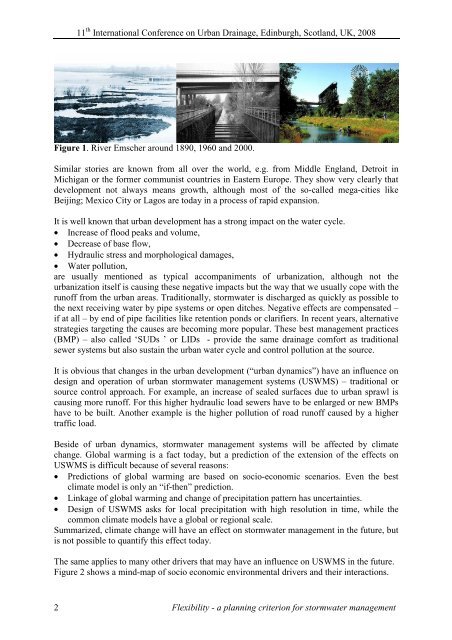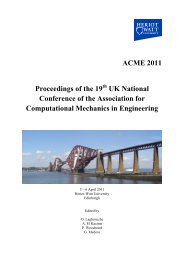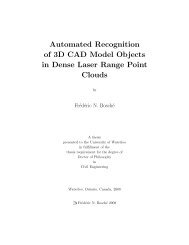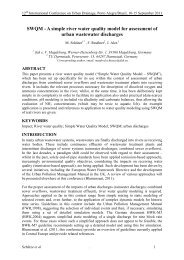Flexibility - a planning criterion for stormwater management
Flexibility - a planning criterion for stormwater management
Flexibility - a planning criterion for stormwater management
You also want an ePaper? Increase the reach of your titles
YUMPU automatically turns print PDFs into web optimized ePapers that Google loves.
11 th International Conference on Urban Drainage, Edinburgh, Scotland, UK, 2008<br />
Figure 1. River Emscher around 1890, 1960 and 2000.<br />
Similar stories are known from all over the world, e.g. from Middle England, Detroit in<br />
Michigan or the <strong>for</strong>mer communist countries in Eastern Europe. They show very clearly that<br />
development not always means growth, although most of the so-called mega-cities like<br />
Beijing; Mexico City or Lagos are today in a process of rapid expansion.<br />
It is well known that urban development has a strong impact on the water cycle.<br />
• Increase of flood peaks and volume,<br />
• Decrease of base flow,<br />
• Hydraulic stress and morphological damages,<br />
• Water pollution,<br />
are usually mentioned as typical accompaniments of urbanization, although not the<br />
urbanization itself is causing these negative impacts but the way that we usually cope with the<br />
runoff from the urban areas. Traditionally, <strong>stormwater</strong> is discharged as quickly as possible to<br />
the next receiving water by pipe systems or open ditches. Negative effects are compensated –<br />
if at all – by end of pipe facilities like retention ponds or clarifiers. In recent years, alternative<br />
strategies targeting the causes are becoming more popular. These best <strong>management</strong> practices<br />
(BMP) – also called ‘SUDs ’ or LIDs - provide the same drainage com<strong>for</strong>t as traditional<br />
sewer systems but also sustain the urban water cycle and control pollution at the source.<br />
It is obvious that changes in the urban development (“urban dynamics”) have an influence on<br />
design and operation of urban <strong>stormwater</strong> <strong>management</strong> systems (USWMS) – traditional or<br />
source control approach. For example, an increase of sealed surfaces due to urban sprawl is<br />
causing more runoff. For this higher hydraulic load sewers have to be enlarged or new BMPs<br />
have to be built. Another example is the higher pollution of road runoff caused by a higher<br />
traffic load.<br />
Beside of urban dynamics, <strong>stormwater</strong> <strong>management</strong> systems will be affected by climate<br />
change. Global warming is a fact today, but a prediction of the extension of the effects on<br />
USWMS is difficult because of several reasons:<br />
• Predictions of global warming are based on socio-economic scenarios. Even the best<br />
climate model is only an “if-then” prediction.<br />
• Linkage of global warming and change of precipitation pattern has uncertainties.<br />
• Design of USWMS asks <strong>for</strong> local precipitation with high resolution in time, while the<br />
common climate models have a global or regional scale.<br />
Summarized, climate change will have an effect on <strong>stormwater</strong> <strong>management</strong> in the future, but<br />
is not possible to quantify this effect today.<br />
The same applies to many other drivers that may have an influence on USWMS in the future.<br />
Figure 2 shows a mind-map of socio economic environmental drivers and their interactions.<br />
2 <strong>Flexibility</strong> - a <strong>planning</strong> <strong>criterion</strong> <strong>for</strong> <strong>stormwater</strong> <strong>management</strong>













